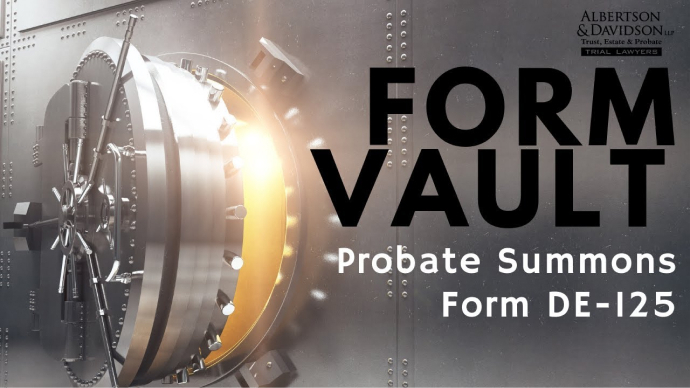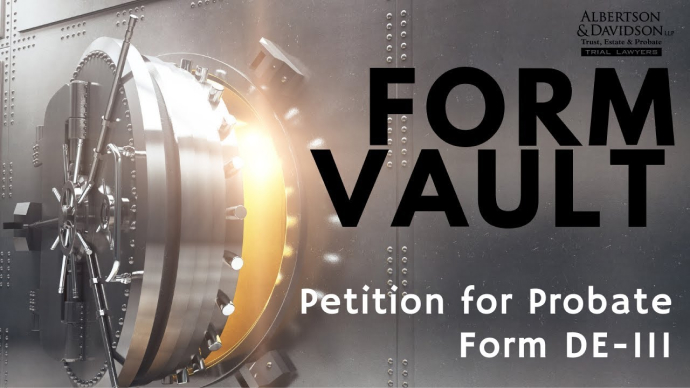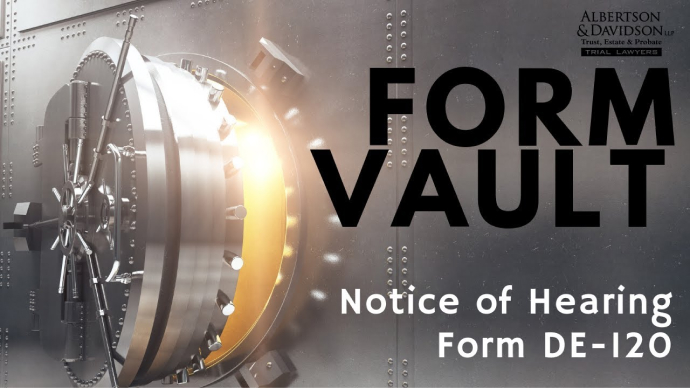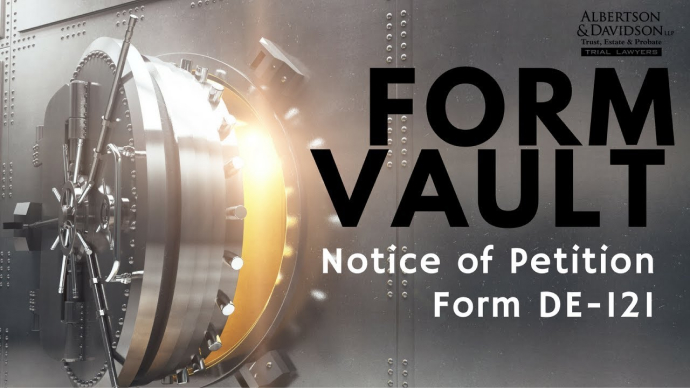Video Transcript
The following is an unedited, verbatim transcript of our video. It is not intended to be a stand-alone article.
Hi, this is Keith Davidson from Albertson & Davidson. In this video, I’m going to discuss a Probate Summons. This is if the court requires you to serve a Summons to a respondent in your probate matter. Typically when your filing a petition in probate, you don’t need to serve a Summons, but occasionally you do with certain types of filings, and this is the form that you’ll use if the court tells you that you need a Summons.
So we’ll start off by going to Google, and just put in judicial council forms, and that will bring up our judicial council website. Today, we’re going to be using form DE-125, which is the Summons for Probate. This is the form that you’re going to use if you doing something, for example, like a Probate Code Section 850 Action, where you’re asking that property be returned to a trust or returned to an estate. And those types of lawsuit require that you personally serve a Summons on the defendant or the respondent, those are the same people. And once they receive the Summons, then they’ve been personally served, they know that they need to answer the complaint, and or answer the petition, and show up in court and state their defense.
Form DE-125
So we start off by filling out the name of the person who you’re going to serve, so in this case, let’s use the example Bob Smith. And then you have to say who it’s from, so let’s just put in John Doe. Then you have to say the estate, so let’s say this is the estate of Herbert Davidson. So, that’s the information now. If you, you have to have a separate Summons for each of your respondents, so if you have multiple people who you’re suing, you do multiple versions of this form. Down here, you’re going to put the case number. So whatever your case number is, you’ll put that in there, and then you’ll have the name and address of the court. So if you’re in Los Angeles, you just put Los Angeles Superior Court, I use Los Angeles as an example because it’s our largest county in California by population, but you also, whatever court that you’re in, you just put it in there, San Diego, San Mateo, Ventura, Orange County, whatever it is, you just type it in there. And then you’ll put the address of the court. And this is so that everybody knows where the action is pending and where they need to file their answer. And then you have the name, address, telephone number of the filing party’s attorney. So this is so when somebody answers a complaint or a petition, they have to file it in the court but they also have to give notice of that, mailed notice of that to the plaintiff for petitioner, and if the plaintiff for petitioner has an attorney then it’ll go to their attorney. So in this case, I would just put my own name in here, if I’m pro per, i would just put my name, and you can actually just type pro per after it. If I’m appearing as a lawyer, I would just put my name and law firm, and then I would just put the address where any paperwork should be sent.
Notice right here, this form is going to be signed by the clerk of the court, but you have to fill out the form first and then you have to take it to the court and the court clerk will sign it, they’ll put their stamp on it. And they’ll also put a seal on it so that you’ll know that it’s been issued by the court. Once the court signs this and out the seal on it, the clerk does that, then you’re going to have to personally serve it. And that’s what the proof of service is for. We’ve gone to a number of proofs of service in our form vault series, but this is where you would just fill out who is serving this form. Now you’ll notice here that at the time of service I was at least 18 years of age and not a party to this action, it’s very important that you personally serve documents that a party to the action cannot be the person who serves this Summons, you have to hire a service, or in some counties you can use the Sheriff’s Department. But normally you’re going to hire a proof of service company, and they’re going to serve this for you. And they’ll fill out who the person who was serve, when they were serve, the address where they were serve, and all of these will be filled out for you.
You’ll see down here that there’s a different options that they can use. So your proof of service company will either hopefully personally deliver it, or there’s different ways to do what we call substituted service if you can’t find the person, sometimes you can leave it at their business or home depending on what rules you’re operating under. You can also have mail service, sometimes when you do substituted service, you have to both leave a cope and mail a copy. So you want to make sure that your proof of service company fills out all the appropriate forms here.
Notice To The Person Served
You also want to make sure that you fill out number 4, which is the “Notice to the Person Served”, as an individual defendant, as the person sued under fictitious name, on behalf of. So you want to make sure that you fill out the right information here as to the person you serve. If you’re just serving an individual, then you can just click that box.
And then the person who served this is going to have to put their information. So if you hire a proof of service company, they’ll fill that out for you, and put their name and information. They’ll also list any fees for service and they’ll have to declare under penalty of perjury that the service was actually done properly.
You’ll notice in number 7, I am a California Sheriff or Marshall, that will be the box that will be checked if you hire the Sheriff’s department to do your proof of service. And the you’ll just date it and you’ll sign this form.




